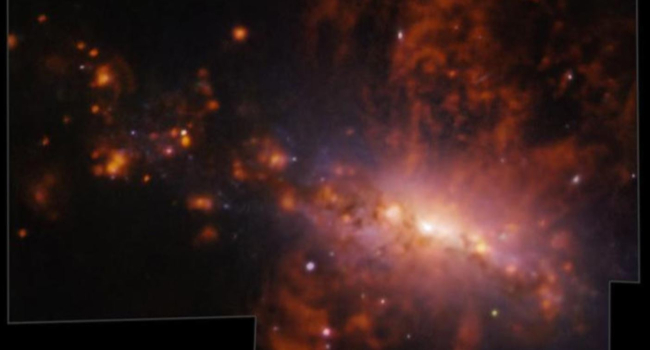
Star formation has produced a 20,000 light-year-long gas plume from the galaxy NGC 4383
Astronomers have discovered a massive gas outflow from the galaxy NGC 4383 using the MUSE spectrograph installed on the Very Large Telescope as part of the MAUVE astronomical program. It is presumed that the outflow was triggered by bursts of star formation and supernova explosions. Studying the structure and composition of this outflow sheds light on star formation cycles in galaxies, Arstechnica.com reports.
An international team of scientists detected a massive outflow of ionized gas in the galaxy NGC 4383, located in the Virgo Cluster. According to Ars Technica, researchers were able to obtain a detailed image of this gas structure with a resolution of 100 parsecs (326 light-years). It was found that the length of the outflow exceeds 19,000 light-years and is the result of active star formation in the central region of NGC 4383. During the process of star formation, a huge amount of various elements, including hydrogen, oxygen, nitrogen, and sulfur, was expelled from the depths of the galaxy. According to estimates by scientists, the total mass of ejected gas is 50 million solar masses, which is quite astonishing.
Astronomers have long suspected that powerful gas outflows play a key role in the evolution of galaxies. Gas expelled from stellar interiors contaminates the interstellar medium inside galaxies and, partially reaching intergalactic space, ceases to serve as raw material for forming new stars. Therefore, it is believed that giant gas outflows can ultimately lead to the demise of galaxies as they lose the ability to form stars and slowly "die off". Observations of NGC 4383 confirm this hypothesis.
Measurements showed that the average velocity of the gas ejected by the galaxy is 210 kilometers per second, with a maximum velocity of 300 kilometers per second. These values are consistent with theoretical models that take into account the visible stellar mass of NGC 4383 and the observed rates of star formation in it. Calculations also show that nearly two million solar masses of matter pass through this gas outflow annually. For comparison, the mass of all matter in our Galaxy is estimated to be approximately 600 billion solar masses.
It is noted that such detailed research into the structure of ionized gas in NGC 4383 became possible thanks to the unique capabilities of modern instruments, including the MUSE spectrograph on the Very Large Telescope of the European Southern Observatory in Chile and the ALMA array of 66 radio telescopes.
The results of the study were obtained within the framework of the international scientific program MAUVE (MUSE and ALMA Unveiling the Virgo Environment), the goal of which is to study the role of powerful gas outflows from galaxies in their further evolution and possible demise.
- Related News
- Samples taken from Moon՛s far side for first time have been removed from capsule and sent for study
- NASA assigned SpaceX the task of landing ISS from space and will pay $843 million for it
- Powerful flare occurs in active part of Sun: What effect did it have on earth?
- China makes a historic breakthrough: Chang'e-6 probe delivers soil samples from the far side of the Moon
- NASA admits it cannot protect the Earth from asteroid collision
- Debris of Chinese rocket fell near the settlement (video)
- Most read
month
week
day
- NASA admits it cannot protect the Earth from asteroid collision 1432
- Why you can’t blindly trust AI: Because of the Google Gemini, a person almost became infected with botulism 872
- Stanford scientists introduce robot capable of accurately reproducing human movements, including in real time 837
- What are the fastest growing AI cryptocurrencies? 780
- 6100 mAh battery, Snapdragon 8 Gen 3, 24 GB RAM: OnePlus Ace 3 Pro to be a flagship killer 711
- Jelly Max: World's smallest 5G phone 699
- China makes a historic breakthrough: Chang'e-6 probe delivers soil samples from the far side of the Moon 624
- How and why is artificial intelligence worsening climate on Earth? 618
- Debris of Chinese rocket fell near the settlement (video) 613
- Visa partners with TransferGo to promote seamless cross-border money transfers to the Caucasus, Central Asia and Moldova 608
- Archive
